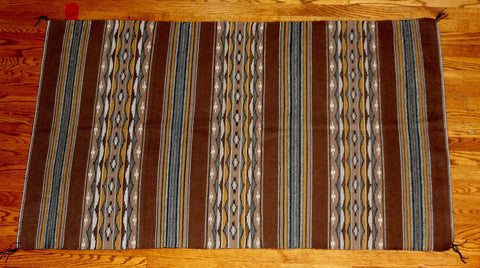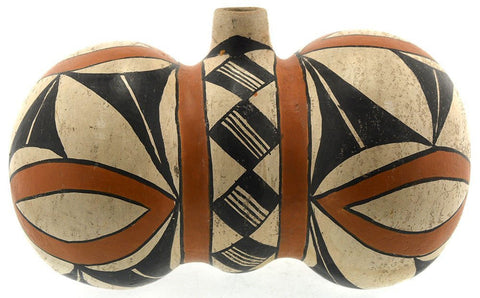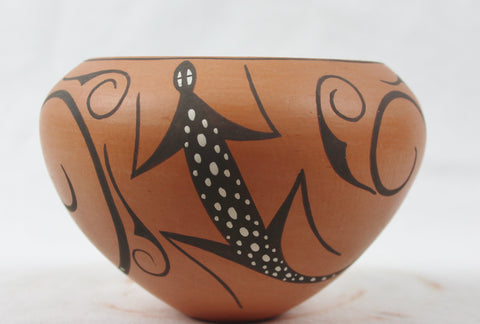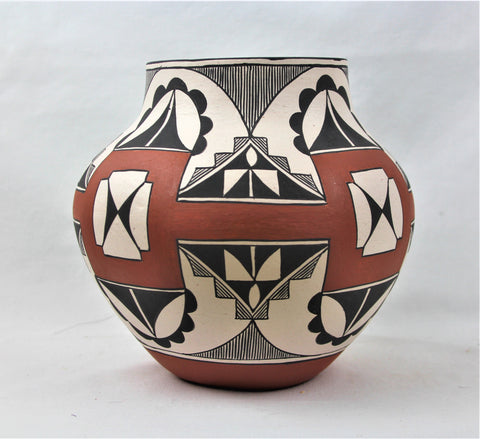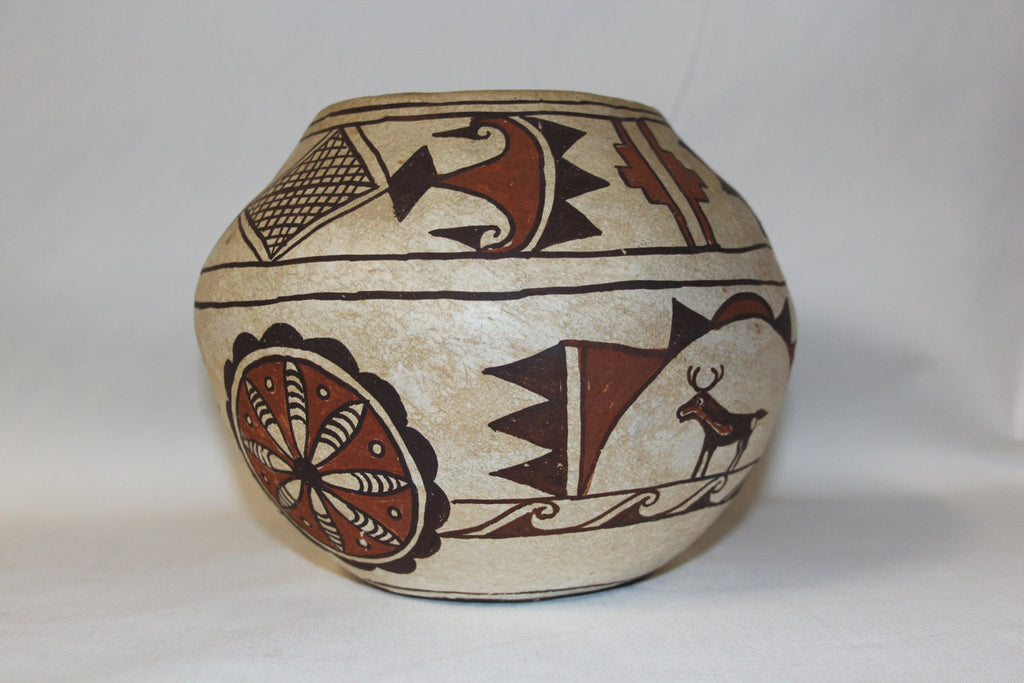
Pottery : Antique Zuni Pottery Vase by Nellie Bica #4 SOLD
$ 1,830.00
Native American
Zuni Pottery
4. Description: Zuni pottery vase, the bulbous form with geometric reserves surrounding the deer frieze, base marked N.B, 5.5"h x 7"w. Artist, Nellie Bica. Provenance from a founding Sonoma County, CA Family. Very good condition for its age. Nice patina.
---------
Nellie Bica (1904-c 1990's) is considered one of the most famous Zuni potters of the mid-20th century. She is especially noted for her pottery owl figures. She was prolific and respected for her fine artistry.
In 1917, Nellie learned to make pottery: "My mother's youngest sister taught me when I was in my teens. Owls were the first potteries I made. That's the way they taught them in those days. I always put babies on my owls. I think I was one of the first to make owls with legs. Now my daughter and three granddaughters make them, too."
After the passing of Tsayutisa and Catalina Zunie, Nellie Bica helped keep pottery making alive at Zuni. Quanita Kalestewa, her daughter, said that Nellie used to fire her pottery early in the morning, "just when the sun rises." Nellie taught her daughter to pray when gathering clay and making pottery.
Nellie made pottery when not working at their family sheep ranch. She was asked to teach pottery at Zuni, but explained that she was too busy with family responsibilities. She was a respected master potter.
Source: from Southern Pueblo Pottery 2,000 Artist Biographies by Gregory Schaaf
---------
A History of Pueblo Pottery:
“Pueblo pottery is made using a coiled technique that came into northern Arizona and New Mexico from the south, some 1500 years ago. In the four-corners region of the US, nineteen pueblos and villages have historically produced pottery. Although each of these pueblos use similar traditional methods of coiling, shaping, finishing and firing, the pottery from each is distinctive.
Various clay's gathered from each pueblo’s local sources produce pottery colors that range from buff to earthy yellows, oranges, and reds, as well as black. Fired pots are sometimes left plain and other times decorated—most frequently with paint and occasionally with appliqué. Painted designs vary from pueblo to pueblo, yet share an ancient iconography based on abstract representations of clouds, rain, feathers, birds, plants, animals and other natural world features.
Tempering materials and paints, also from natural sources, contribute further to the distinctiveness of each pueblo’s pottery. Some paints are derived from plants, others from minerals. Before firing, potters in some pueblos apply a light colored slip to their pottery, which creates a bright background for painted designs or simply a lighter color plain ware vessel. Designs are painted on before firing, traditionally with a brush fashioned from yucca fiber.
Different combinations of paint color, clay color, and slips are characteristic of different pueblos. Among them are black on cream, black on buff, black on red, dark brown and dark red on white (as found in Zuni pottery), matte red on red, and polychrome—a number of natural colors on one vessel (most typically associated with Hopi). Pueblo potters also produce undecorated polished black ware, black on black ware, and carved red and carved black wares.
Making pueblo pottery is a time-consuming effort that includes gathering and preparing the clay, building and shaping the coiled pot, gathering plants to make the colored dyes, constructing yucca brushes, and, often, making a clay slip. While some Pueblo artists fire in kilns, most still fire in the traditional way in an outside fire pit, covering their vessels with large potsherds and dried sheep dung. Pottery is left to bake for many hours, producing a high-fired result.
Today, Pueblo potters continue to honor this centuries-old tradition of hand-coiled pottery production, yet value the need for contemporary artistic expression as well. They continue to improve their style, methods and designs, often combining traditional and contemporary techniques to create striking new works of art.” (Source: Museum of Northern Arizona)
----------
View the other items in my shop: http://www.etsy.com/shop/CulturalPatina?ref=shopsection_shophome_leftnav

